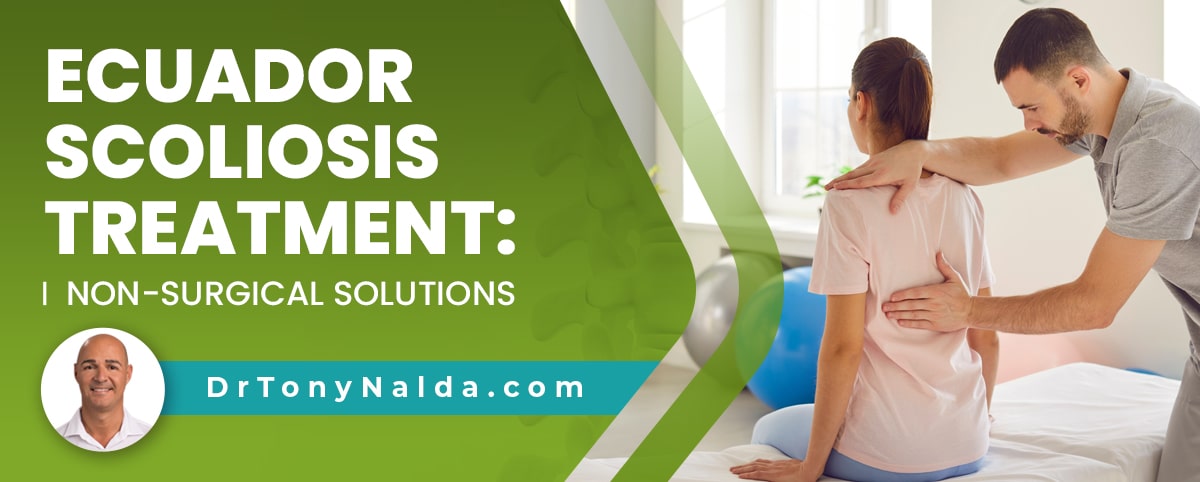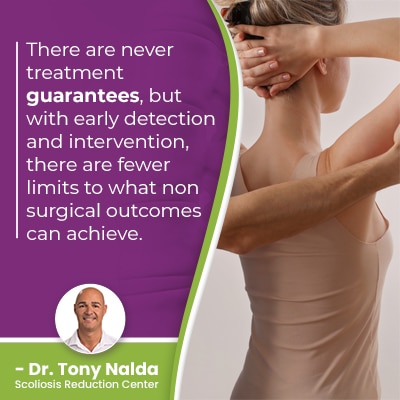Ecuador Scoliosis Treatment: Non-Surgical Solutions

While scoliosis affects all ages, it's most often diagnosed in children, and as a progressive condition triggered by growth, childhood scoliosis can involve a lot of potential progression. Childhood scoliosis should always be taken seriously, and there are a number of benefits associated with early detection and intervention.
Ecuador scoliosis treatment can include Orlando, Florida's Scoliosis Reduction Center® with a 4.5-hour flight. The Center is known for its innovative non-surgical scoliosis treatment options, and Dr. Tony Nalda has become a renowned scoliosis chiropractor over the years.
In order to treat scoliosis effectively, a customized treatment plan needs to be crafted around key patient/condition variables; comprehensive assessment is part of diagnosing the complex spinal condition.
Table of Contents
Diagnosing and Classifying Scoliosis
Diagnosing scoliosis means an unnatural sideways-bending spinal curvature has developed, and the spine doesn't just bend unnaturally to the side, it also twists, making scoliosis a complex 3-dimensional condition.
In order to be diagnosed as a true scoliosis, there has to be rotation and a minimum Cobb angle measurement of 10 degrees, and this is where an X-ray is necessary.
An X-ray is needed to see what's really happening in and around the spine, to confirm the rotation, and to determine a patient's Cobb angle.
Condition Severity
Cobb angle is a condition classification point as it determines condition severity.
- Mild scoliosis: Cobb angle measurement of between 10 and 25 degrees
- Moderate scoliosis: Cobb angle of between 25 and 40 degrees
- Severe scoliosis: Cobb angle of 40+ degrees
- Very-severe scoliosis: Cobb angle of 80+ degrees
The higher a patient's Cobb angle, the more severe the condition, and the more noticeable its effects are likely to be.
Additional classification points include patient age, condition type, and curvature location.
Patient Age
 When it comes to children, all ages can be affected, and childhood scoliosis includes congenital scoliosis, infantile scoliosis, juvenile scoliosis, and adolescent idiopathic scoliosis; adult scoliosis is diagnosed once skeletal maturity has been reached.
When it comes to children, all ages can be affected, and childhood scoliosis includes congenital scoliosis, infantile scoliosis, juvenile scoliosis, and adolescent idiopathic scoliosis; adult scoliosis is diagnosed once skeletal maturity has been reached.
Adolescent idiopathic scoliosis is diagnosed between the ages of 10 and reaching skeletal maturity and is the most common form overall.
Patient age is important because as a progressive condition triggered by growth, the more growth a patient has to go through before reaching skeletal maturity means the more potential progression there is to face, and adolescents are the most at risk for rapid progression due to the unpredictable and rapid growth spurts of puberty.
Patient age also indicates how painful a condition is likely to be; scoliosis doesn't become a compressive condition until skeletal maturity has been reached, so for children, it doesn't commonly involve noticeable back and radiating pain, especially when mild, but scoliosis pain is the main symptom of adult scoliosis.
Condition Type
Condition type is determined by causation, and in the majority of cases, we don't know what causes the condition to develop, and this is classified as idiopathic scoliosis.
Idiopathic scoliosis accounts for approximately 80 percent of known cases, and the remaining 20 percent are associated with known causes: neuromuscular scoliosis, degenerative scoliosis, and congenital scoliosis.
A condition's underlying cause has to be the focus of treatment, and when it comes to idiopathic scoliosis, I explain to patients that not knowing the cause doesn't affect the course of treatment or its outcome; what's most important is how a diagnosis is responded to, and when it's responded to.
Curvature Location
There are three main spinal sections, and scoliosis can develop in any one section, or in more than one as a combined scoliosis.
The cervical spine refers to the neck.
Thoracic spine is the largest spinal section and includes the middle/upper back.
The lumbar spine refers to the lower back.
Curve location is important not just because it tells me where to concentrate my treatment efforts, but also because it indicates the type of symptoms a patient is likely to experience.
However, because there are so many variables that shape a person's experience of life with their condition, no two cases are the same, and symptoms one patient experiences don't always indicate what others will face.
In most cases, the area of the body located the closest to an affected spinal section is going to feel the majority of its direct effects; for example, in cases of lumbar scoliosis that develop in the lower back, a common complication includes sciatic nerve pain.
As the sciatic nerve starts in the lower back, an unnatural spinal curve in the lower spine can expose the sciatic nerve to uneven pressure, pinching it, and causing it to become irritated.
Once conditions are classified accordingly, a treatment plan can be crafted accordingly.
Non Surgical Scoliosis Treatment
There are different ways to address childhood scoliosis, and as progression is such a danger, a focus is on counteracting the condition's progressive nature, and how to hold results despite the constant trigger of growth occurring.
 There are never treatment guarantees, but with early detection and intervention, there are fewer limits to what non-surgical outcomes can achieve.
There are never treatment guarantees, but with early detection and intervention, there are fewer limits to what non-surgical outcomes can achieve.
Spine surgery is invasive and risky, and while it still has a place in scoliosis treatment, particularly for severe cases and/or atypical cases, the reality is that many cases of scoliosis don't require surgical treatment.
Scoliosis surgery is a type of spinal fusion, and conservative treatment offers a non-surgical alternative that's more aligned with the spine's natural design and function.
The Scoliosis Research Society has current estimates at close to seven million people currently living with scoliosis in the United States alone, so the condition warrants awareness.
Many scoliosis patients who have received spine surgery are disappointed with the spinal rigidity they are left with, and a fused spine is weaker and more vulnerable to injury.
Non surgical treatment offered by the Scoliosis Reduction Center® is innovative and integrative: combining the power of multiple treatment disciplines, made possible by Dr. Tony's extensive training and certifications in a number of areas.
Non surgical treatment combines chiropractic care, physical therapy, scoliosis exercises, corrective bracing, and rehabilitation, and values a proactive response to a diagnosis.
Proactive Scoliosis Treatment
Proactive scoliosis treatment is started as close to the time of diagnosis as possible, when conditions are going to be at their mildest and the most treatable.
The earlier a condition is diagnosed in its progressive line, the better, because it means treatment can be started early, and while there are never guarantees, early detection and intervention is associated with treatment success.
Smaller curves are easier to correct not only because they are more mild, but also because progression causes the spine to become increasingly rigid, making it less responsive to treatment and disrupting some patients' ability to perform key therapeutic exercises as part of treatment.
Prevention
Proactive scoliosis treatment is about working towards prevention: preventing progression, increasing condition effects, and the need for invasive surgery and its potential long term complications.
Conservative treatment uses chiropractic care to work towards impacting the condition's underlying structural nature through adjusting the position of the curve's most-tilted vertebrae: improving the spine's alignment and restoring as much of its healthy curves as possible.
Non surgical treatment also includes the spine's surrounding muscles that need to support and stabilize the spine.
Physical therapy and scoliosis exercise work towards improving the balance and strength of the spine's surrounding muscles, and this is a key focus of non surgical treatment.
Childhood scoliosis can be highly responsive to bracing as a facet of treatment because the spine is still growing and is more malleable; this can help my pushing the spine into a straighter alignment and healthier position.
Rehabilitation reminds us that there is no curing scoliosis; as a progressive condition, treatment is more about managing an ongoing condition.
Conclusion
Ecuador residents can access Dr. Tony's non surgical scoliosis treatment center with a 4.5-hour flight, and once a patient of the Center, many powerful treatment disciplines are accessible under one roof.
Not everyone has the same access to medical treatment and alternative options including middle income countries like Ecuador, and when it comes to scoliosis treatment, as an ongoing condition, how it's treated can shape a person's quality of life; innovative treatment can be worth traveling for.
When it comes to a surgical response, traditional treatment commonly recommends watching and waiting while conditions are mild, and is known to respond with surgical treatment when scoliosis becomes severe, but little is done beforehand to prevent progression.
To me, watching and waiting to see if a progressive condition progresses is wasting valuable treatment time, and this is one of the main benefits offered by the Center: a proactive approach.
So don't hesitate to reach out to Orlando, Florida's Scoliosis Reduction Center to schedule a consultation; it can be the first step on the road to guidance, support, and treatment success.
Dr. Tony Nalda
DOCTOR OF CHIROPRACTIC
After receiving an undergraduate degree in psychology and his Doctorate of Chiropractic from Life University, Dr. Nalda settled in Celebration, Florida and proceeded to build one of Central Florida’s most successful chiropractic clinics.
His experience with patients suffering from scoliosis, and the confusion and frustration they faced, led him to seek a specialty in scoliosis care. In 2006 he completed his Intensive Care Certification from CLEAR Institute, a leading scoliosis educational and certification center.
About Dr. Tony Nalda
 Ready to explore scoliosis treatment? Contact Us Now
Ready to explore scoliosis treatment? Contact Us Now





